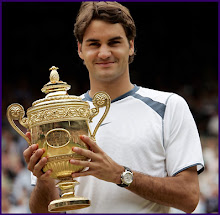 A serve (or, more formally, a service) in tennis is a shot to start a point. The serve is usually initiated by tossing the ball into the air and hitting it (usually near the apex of its trajectory) into the diagonally opposite service box without touching the net. It may be performed underhand or overhead. The serve is the only shot where a player can take his time to set up, instead of having to react to an opponent's shot.
A serve (or, more formally, a service) in tennis is a shot to start a point. The serve is usually initiated by tossing the ball into the air and hitting it (usually near the apex of its trajectory) into the diagonally opposite service box without touching the net. It may be performed underhand or overhead. The serve is the only shot where a player can take his time to set up, instead of having to react to an opponent's shot. The serve is one of the more difficult shots for a novice, but once mastered it can be a considerable advantage. Advanced players can hit the serve in many different ways and often use it as an offensive weapon to gain an advantage in the point or to win it outright. Because of this, professional players win most of their service games, and breaking serve plays a crucial role in a match.
coming soon : more on Serving





